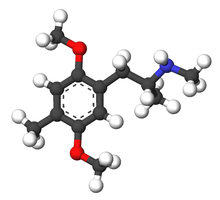Beatrice (psychedelic)
Beatrice (also known as MDO-D, MDOM, 2C-D, and 4-methyl-2,5-dimethoxymethamphetamine) is a lesser-known psychedelic drug. It is a substituted methamphetamine and a homolog of 2,5-dimethoxy-4-methylamphetamine (DOM). Beatrice was first synthesized by Alexander Shulgin. In his book PiHKAL, the minimum dosage is listed as 30 mg, and the duration listed as 6–10 hours.[1] Beatrice produces a vague feeling of openness and receptiveness, and causes a stimulative effect. It also causes diarrhea. Very little data exists about the pharmacological properties, metabolism, and toxicity of beatrice.
.png) | |
 | |
| Names | |
|---|---|
| IUPAC name
1-(2,5-Dimethoxy-4-methylphenyl)-N-methylpropan-2-amine | |
| Other names
4-Methyl-2,5-dimethoxy-methamphetamine 2-(4-Methyl-2,5-dimethoxyphenyl)ethan-alpha,N-methylamine | |
| Identifiers | |
CAS Number |
|
3D model (JSmol) |
|
| ChEMBL | |
| ChemSpider | |
PubChem CID |
|
InChI
| |
SMILES
| |
| Properties | |
Chemical formula |
C13H21NO2 |
| Molar mass | 223.316 g·mol−1 |
Except where otherwise noted, data are given for materials in their standard state (at 25 °C [77 °F], 100 kPa). | |
| Infobox references | |
See also
- 4-Methylmethamphetamine
- Phenethylamine
- Psychedelics, dissociatives and deliriants
- Ganesha (psychedelic)
References
This article is issued from
Wikipedia.
The text is licensed under Creative
Commons - Attribution - Sharealike.
Additional terms may apply for the media files.